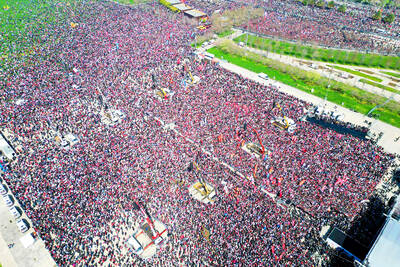The Chinese government says the mastermind behind the violent clashes between Muslim Uighurs and ethnic Han Chinese in China’s Xinjiang region is a diminutive grandmother with long, salt-and-pepper braids living in exile in a suburb of the US capital.
Once one of the richest women in Xinjiang and held up as an exemplar of China’s purported multi-ethnic harmony, Rebiya Kadeer now heads two prominent Uighur exile groups, speaking out against Beijing’s oppression of the Turkic-speaking minority. Beijing has accused Kadeer of organizing the protests that have left at least 156 dead and more than 1,000 injured, accusations she has denied.
Kadeer’s persecution by the Chinese and her stature as a public face of the Uighur people have earned her comparisons to the Dalai Lama, the exiled Tibetan spiritual leader.
Before her exile, Kadeer, 62, rose from poverty to become a successful entrepreneur, running trading companies and department stores. Beijing named her in China’s official delegation to the 1995 UN conference on women in Beijing and to the country’s legislature.
By 1997 she had formed an organization to aid Uighur women and had opened a Uighur language school, an action tinged with enough separatism to earn her scrutiny from Chinese security agencies. In August 1999 Kadeer was detained in Urumqi as she headed to meet US congressional staff members. She was charged with passing state secrets to foreigners and sentenced to eight years in prison.
The US government and human rights groups across the world pressed for her release. In 2005, the Chinese government released her from jail and put her on a plane to northern Virginia.

A fire caused by a burst gas pipe yesterday spread to several homes and sent a fireball soaring into the sky outside Malaysia’s largest city, injuring more than 100 people. The towering inferno near a gas station in Putra Heights outside Kuala Lumpur was visible for kilometers and lasted for several hours. It happened during a public holiday as Muslims, who are the majority in Malaysia, celebrate the second day of Eid al-Fitr. National oil company Petronas said the fire started at one of its gas pipelines at 8:10am and the affected pipeline was later isolated. Disaster management officials said shutting the

US Vice President J.D. Vance on Friday accused Denmark of not having done enough to protect Greenland, when he visited the strategically placed and resource-rich Danish territory coveted by US President Donald Trump. Vance made his comment during a trip to the Pituffik Space Base in northwestern Greenland, a visit viewed by Copenhagen and Nuuk as a provocation. “Our message to Denmark is very simple: You have not done a good job by the people of Greenland,” Vance told a news conference. “You have under-invested in the people of Greenland, and you have under-invested in the security architecture of this

Japan unveiled a plan on Thursday to evacuate around 120,000 residents and tourists from its southern islets near Taiwan within six days in the event of an “emergency”. The plan was put together as “the security situation surrounding our nation grows severe” and with an “emergency” in mind, the government’s crisis management office said. Exactly what that emergency might be was left unspecified in the plan but it envisages the evacuation of around 120,000 people in five Japanese islets close to Taiwan. China claims Taiwan as part of its territory and has stepped up military pressure in recent years, including

UNREST: The authorities in Turkey arrested 13 Turkish journalists in five days, deported a BBC correspondent and on Thursday arrested a reporter from Sweden Waving flags and chanting slogans, many hundreds of thousands of anti-government demonstrators on Saturday rallied in Istanbul, Turkey, in defence of democracy after the arrest of Istanbul Mayor Ekrem Imamoglu which sparked Turkey’s worst street unrest in more than a decade. Under a cloudless blue sky, vast crowds gathered in Maltepe on the Asian side of Turkey’s biggest city on the eve of the Eid al-Fitr celebration which started yesterday, marking the end of Ramadan. Ozgur Ozel, chairman of the main opposition Republican People’s Party (CHP), which organized the rally, said there were 2.2 million people in the crowd, but